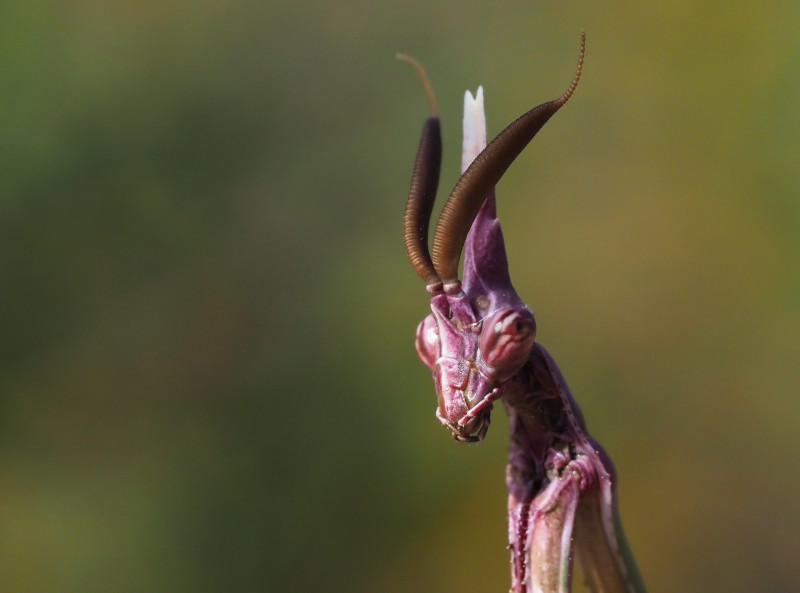
Agile Ground Mantis Facts
- This marvel of Nature and evolution most typically goes by the informative common name of the Agile Ground Mantis. It does have several other, though very similar, general titles, though. These include minor ground mantis and lesser ground mantis.
- Among scientific professionals, however, it’s likely much better known by its technical title. Pleasantly, that’s a simple term for the layperson to pronounce, at least comparatively. That’s because it holds the official moniker of Litaneutria minor.
- The invertebrate received that relatively simple title due to the efforts of the American entomologist, Samuel Hubbard Scutter. The noted scientist managed the first acknowledgement of it as a separate and distinct species. That event occurred in 1872.
- No matter which of these one uses, it remains a fascinating creation of evolutionary processes. Even in comparison to its peers, it’s considered as quite aggressive. It also happens to represent the only native species of mantis within portions of its range.
- Thankfully, the Agile Ground Mantis appears to be maintaining a population base that’s both stable and sufficient. That pleasantly surprising situation further seems to hold true throughout its territory. The IUCN thus currently has no listing for the small insect.
- It nevertheless must be considered to be facing at least a few potential threats to its continued existence. Like most species, the majority of the stem from the actions of humans. They include such dangers as habitat loss and ongoing climate change.
Related Articles




Agile Ground Mantis Physical Description
The Agile Ground Mantis typically fascinates those fortunate enough to encounter it. The Arthropod tends to do so for several reasons, but sheer physical size isn’t among them. That’s true since, despite its other amazing attributes, it’s a small variety of mantis.
Like most of its kin, though, it displays a degree of the physiological characteristic of sexual dimorphism. Unlike the majority of species, however, that doesn’t mainly manifest itself in terms of general appearance. Instead it shows in an extremely sharp physical difference.
Adults of both genders of this fabulous insect attain the same approximate dimensions. While many mantids reach lengths of 2 – 5 in (5 – 12 cm), this one remains much smaller. Mature specimens of the wonder grow to average lengths measuring 1.2 in (3 cm).
The gender-based variation partially shows itself in regards to the construction of the abdomen of the nonetheless impressive invertebrate. Males of this member of its genus display 8 segments here. Their female counterparts, meanwhile, only possess 6 sections.
Yet the most extreme divergence in the Agile Ground Mantis presents itself in regards to the wings. Males generally have seemingly strong, efficient wings. Despite this fact, they do not take flight. The females of the unique animal, by contrast, lack wings entirely!
Except for this fundamental difference, though, the sexes appear nearly identical. Mature specimens manifest either a tan or dark gray shade. This varies in shade randomly across the body. Males also have a small brown spot near the forewing base that the females lack.
- Kingdom: Animalia
- Phylum: Arthropoda
- Class: Insecta
- Order: Mantodea
- Family: Amelidae
- Genus: Litaneutria
- Species: L. minor

Agile Ground Mantis Distribution, Habitat, and Ecology
The intriguing Agile Ground Mantis evolved as endemic to a moderately wide section of the earth’s surface. The general region of the earth it appears in likely won’t surprise many people, though. That’s true since in developed as native to parts of North America.
Within that area, however, its range is disjunct. In the southernmost portion of its territory, it appears in northern Mexico. From there, it shows itself in Arizona, Colorado, and eastern Washington and California, in the United States, and one valley in southern Canada.
This marvel of Nature also developed some surprising preferences regarding its choice of habitat. That’s true since, unlike most mantises, it lives in more arid regions. Despite what one might think, the small but intrepid insect thrives in its chosen zone of habitation.
The nature of this environment serves its purposes well, however. Its natural color patterns provide it with excellent camouflage, both for its own protection and as an aid in hunting. It divides its time between the dry ground around it, and the sparse yet sufficient local flora.
From both vantage points, the Agile Ground Mantis is a master of its domain. Unlike most mantises, it often actively hunts its prey, rather than laying in wait. It frequently pursues its prey across the ground with great proficiency and agility, thus the applied common name.
Like its relatives, it’s a carnivorous creature. Its diet mainly consists of flies, grasshoppers, moths, crickets, and katydids. Nevertheless, it’s also opportunistic, feeding on virtually any small prey it can catch. It’s also primarily solitary, coming together only for mating purposes.
Species Sharing Its Range



Check oout out other articles on 5 Marvelous Mediterranean Sea Species, Harp Seal, Great Barrier Reef, Rosy Veincap, Scalloped Hammerhead, Alligator Snapping Turtle, Autumn Meadowhawk









Leave a Reply